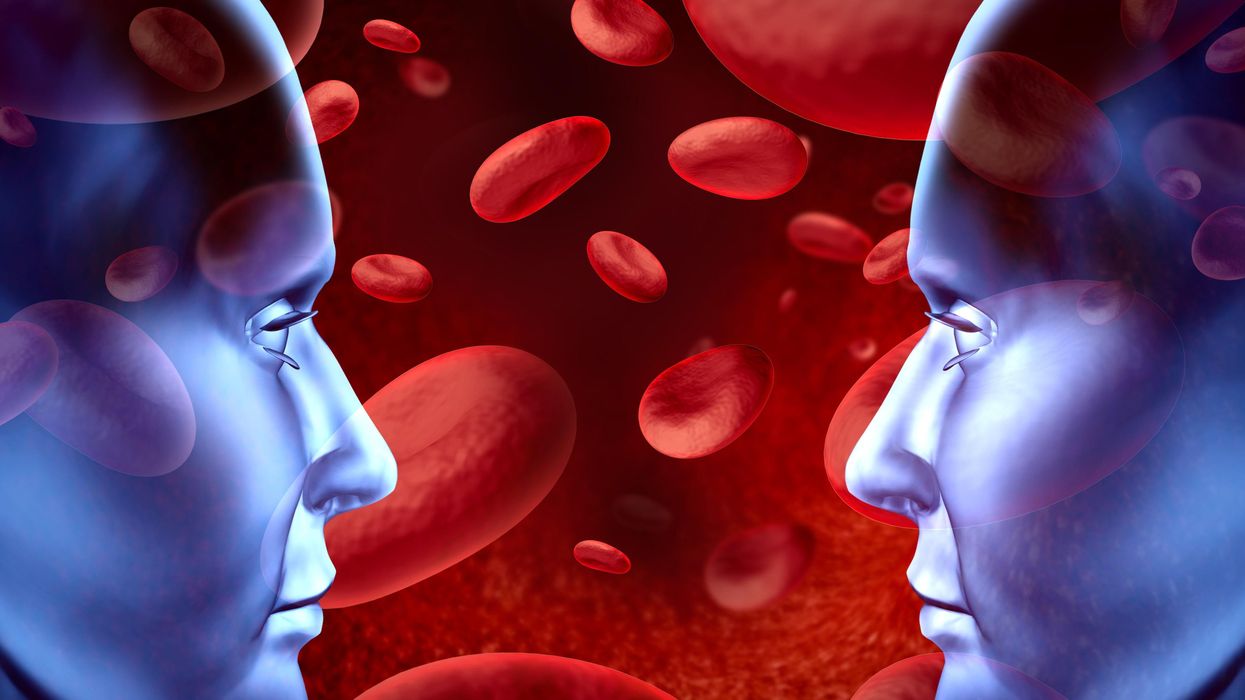Saliva May Help Diagnose PTSD in Veterans

A recent study finds that former soldiers with post traumatic stress disorders have a certain set of bacteria in their saliva, a distinct signature that is believed to be the first biological marker for PTSD.
As a bioinformatician and young veteran, Guy Shapira welcomed the opportunity to help with conducting a study to determine if saliva can reveal if war veterans have post-traumatic stress disorder, or PTSD.
The research team, which drew mostly from Tel Aviv University’s Sackler Faculty of Medicine and Sagol School of Neuroscience, collected saliva samples from approximately 200 veterans who suffered psychological trauma stemming from the years they spent fighting in the First Lebanon War in 1982. The researchers also characterized the participants’ psychological, social and medical conditions, including a detailed analysis of their microbiomes.
They found that the former soldiers with PTSD have a certain set of bacteria in their saliva, a distinct microbiotic signature that is believed to be the first biological marker for PTSD. The finding suggests that, in the future, saliva tests could be used to help identify this disorder. As of now, PTSD is often challenging to diagnose.
Shapira, a Ph.D. student at Tel Aviv University, was responsible for examining genetic and health-related data of the veterans who participated – information that had been compiled steadily over four decades. The veterans provided this data voluntarily, Shapira says, at least partly because the study carries important implications for their own psychological health.
The research was led by Illana Gozes, professor emerita of clinical biochemistry. “We looked at the bacteria in their blood and their saliva,” Gozes explains. To discover the microbial signatures, they analyzed the biometric data for each soldier individually and as a group. Comparing the results of the participants’ microbial distribution to the results of their psychological examinations and their responses to personal welfare questionnaires, the researchers learned that veterans with PTSD – and, more generally, those with significant mental health issues – have the same bacterial content in their saliva.
“Having empirical metrics to assess whether or not someone has PTSD can help veterans who make their case to the Army to get reparations,” Shapira says.
More research is required to support this finding, published in July in Nature’s prestigious Molecular Psychiatry, but it could have important implications for identifying people with PTSD. Currently, it can be diagnosed only through psychological and behavioral symptoms such as flashbacks, nightmares, sleep disorders, increased irritability and physical aggressiveness. Veterans sometimes don’t report these symptoms to health providers or realize they’re related to the trauma they experienced during combat.
The researchers also identified a correlation that indicates people with a higher level of education show a lower occurrence of the microbiotic signature linked to PTSD, while people who experienced greater exposure to air pollution show a higher occurrence of this signature. That confirms their finding that the veterans’ health is dependent on their individual biology combined with the conditions of their environment.
“Thanks to this study, it may be possible in the future to use objective molecular and biological characteristics to distinguish PTSD sufferers, taking into account environmental influences,” Gozes said in an article in Israel21c. “We hope that this new discovery and the microbial signatures described in this study might promote easier diagnosis of post-traumatic stress in soldiers so they can receive appropriate treatment.”
Gozes added that roughly a third of the subjects in their study hadn’t been diagnosed with PTSD previously. That meant they had never received any support from Israel’s Ministry of Defense or other officials for treatment and reparations, the payments to compensate for injuries sustained during war.
Shapira’s motivation to participate in this study is personal as well as professional: in addition to being veteran himself, his father served in the First Lebanon War. “Fortunately, he did not develop any PTSD, despite being shot in the foot...some of his friends died, so it wasn’t easy on him,” says Shapira.
“Having empirical metrics to assess whether or not someone has PTSD can help veterans who make their case to the Army to get reparations,” Shapira says. “It is a very difficult and demanding process, so the more empirical metrics we have to assess PTSD, the less people will have to suffer in these committees and unending examinations that are mostly pitched against the veterans because the state is trying to avoid spending too much money.”
The Friday Five: A new blood test to detect Alzheimer's
A new blood test has been developed to detect Alzheimer's. Other promising studies covered in this week's Friday Five include: vets with PTSD can take their psychologist anywhere with a new device, intermittent fasting could improve circadian rhythms, a new year's resolution for living longer, and a discovery in 3-D printing eye tissue.
The Friday Five covers five stories in research that you may have missed this week. There are plenty of controversies and troubling ethical issues in science – and we get into many of them in our online magazine – but this news roundup focuses on scientific creativity and progress to give you a therapeutic dose of inspiration headed into the weekend.
Listen on Apple | Listen on Spotify | Listen on Stitcher | Listen on Amazon | Listen on Google
Here are the promising studies covered in this week's Friday Five:
- A blood test to detect Alzheimer's
- War vets can take their psychologist wherever they go
- Does intermittent fasting affect circadian rhythms?
- A new year's resolution for living longer
- 3-D printed eyes?
Staying well in the 21st century is like playing a game of chess
The control of infectious diseases was considered to be one of the “10 Great Public Health Achievements.” What we didn’t take into account was the very concept of evolution: as we built better protections, our enemies eventually boosted their attacking prowess, so soon enough we found ourselves on the defensive once again.
This article originally appeared in One Health/One Planet, a single-issue magazine that explores how climate change and other environmental shifts are increasing vulnerabilities to infectious diseases by land and by sea. The magazine probes how scientists are making progress with leaders in other fields toward solutions that embrace diverse perspectives and the interconnectedness of all lifeforms and the planet.
On July 30, 1999, the Centers for Disease Control and Prevention published a report comparing data on the control of infectious disease from the beginning of the 20th century to the end. The data showed that deaths from infectious diseases declined markedly. In the early 1900s, pneumonia, tuberculosis and diarrheal diseases were the three leading killers, accounting for one-third of total deaths in the U.S.—with 40 percent being children under five.
Mass vaccinations, the discovery of antibiotics and overall sanitation and hygiene measures eventually eradicated smallpox, beat down polio, cured cholera, nearly rid the world of tuberculosis and extended the U.S. life expectancy by 25 years. By 1997, there was a shift in population health in the U.S. such that cancer, diabetes and heart disease were now the leading causes of death.
The control of infectious diseases is considered to be one of the “10 Great Public Health Achievements.” Yet on the brink of the 21st century, new trouble was already brewing. Hospitals were seeing periodic cases of antibiotic-resistant infections. Novel viruses, or those that previously didn’t afflict humans, began to emerge, causing outbreaks of West Nile, SARS, MERS or swine flu.In the years that followed, tuberculosis made a comeback, at least in certain parts of the world. What we didn’t take into account was the very concept of evolution: as we built better protections, our enemies eventually boosted their attacking prowess, so soon enough we found ourselves on the defensive once again.
At the same time, new, previously unknown or extremely rare disorders began to rise, such as autoimmune or genetic conditions. Two decades later, scientists began thinking about health differently—not as a static achievement guaranteed to last, but as something dynamic and constantly changing—and sometimes, for the worse.
What emerged since then is a different paradigm that makes our interactions with the microbial world more like a biological chess match, says Victoria McGovern, a biochemist and program officer for the Burroughs Wellcome Fund’s Infectious Disease and Population Sciences Program. In this chess game, humans may make a clever strategic move, which could involve creating a new vaccine or a potent antibiotic, but that advantage is fleeting. At some point, the organisms we are up against could respond with a move of their own—such as developing resistance to medication or genetic mutations that attack our bodies. Simply eradicating the “opponent,” or the pathogenic microbes, as efficiently as possible isn’t enough to keep humans healthy long-term.
Instead, scientists should focus on studying the complexity of interactions between humans and their pathogens. “We need to better understand the lifestyles of things that afflict us,” McGovern says. “The solutions are going to be in understanding various parts of their biology so we can influence how they behave around our systems.”
Genetics and cell biology, combined with imaging techniques that allow one to see tissues and individual cells in actions, will enable scientists to define and quantify what it means to be healthy at the molecular level.
What is being proposed will require a pivot to basic biology and other disciplines that have suffered from lack of research funding in recent years. Yet, according to McGovern, the research teams of funded proposals are answering bigger questions. “We look for people exploring questions about hosts and pathogens, and what happens when they touch, but we’re also looking for people with big ideas,” she says. For example, if one specific infection causes a chain of pathological events in the body, can other infections cause them too? And if we find a way to break that chain for one pathogen, can we play the same trick on another? “We really want to see people thinking of not just one experiment but about big implications of their work,” McGovern says.
Jonah Cool, a cell biologist, geneticist and science officer at the Chan Zuckerberg Initiative, says that it’s necessary to define what constitutes a healthy organism and how it overcomes infections or environmental assaults, such as pollution from forest fires or toxins from industrial smokestacks. An organism that catches a disease isn’t necessarily an unhealthy one, as long as it fights it off successfully—an ability that arises from the complex interplay of its genes, the immune system, age, stress levels and other factors. Modern science allows many of these factors to be measured, recorded and compared. “We need a data-driven, deep-phenotyping approach to defining healthy biological systems and their responses to insults—which can be infectious disease or environmental exposures—and their ability to navigate their way through that space,” Cool says.
Genetics and cell biology, combined with imaging techniques that allow one to see tissues and individual cells in actions, will enable scientists to define and quantify what it means to be healthy at the molecular level. “As a geneticist and cell biologist, I believe in all these molecular underpinnings and how they arise in phenotypic differences in cells, genes, proteins—and how their combinations form complex cellular states,” Cool says.
Julie Graves, a physician, public health consultant, former adjunct professor of management, policy and community health at the University of Texas Health Science Center in Houston, stresses the necessity of nutritious diets. According to the Rockefeller Food Initiative, “poor diet is the leading risk factor for disease, disability and premature death in the majority of countries around the world.” Adequate nutrition is critical for maintaining human health and life. Yet, Western diets are often low in essential nutrients, high in calories and heavy on processed foods. Overconsumption of these foods has contributed to high rates of obesity and chronic disease in the U.S. In fact, more than half of American adults have at least one chronic disease, and 27 percent have more than one—which increases vulnerability to COVID-19 infections, according to the 2018 National Health Interview Survey.
Further, the contamination of our food supply with various agricultural and industrial toxins—petrochemicals, pesticides, PFAS and others—has implications for morbidity, mortality, and overall quality of life. “These chemicals are insidiously in everything, including our bodies,” Graves says—and they are interfering with our normal biological functions. “We need to stop how we manufacture food,” she adds, and rid our sustenance of these contaminants.
According to the Humane Society of the United States, factory farms result in nearly 40 percent of emissions of methane. Concentrated animal feeding operations or CAFOs may serve as breeding grounds for pandemics, scientists warn, so humans should research better ways to raise and treat livestock. Diego Rose, a professor of food and nutrition policy at Tulane University School of Public Health & Tropical Medicine, and his colleagues found that “20 percent of Americans’ diets account for about 45 percent of the environmental impacts [that come from food].” A subsequent study explored the impacts of specific foods and found that substituting beef for chicken lowers an individual’s carbon footprint by nearly 50 percent, with water usage decreased by 30 percent. Notably, however, eating too much red meat has been associated with a variety of illnesses.
In some communities, the option to swap food types is limited or impossible. For example, “many populations live in relative food deserts where there’s not a local grocery store that has any fresh produce,” says Louis Muglia, the president and CEO of Burroughs Wellcome. Individuals in these communities suffer from an insufficient intake of beneficial macronutrients, and they’re “probably being exposed to phenols and other toxins that are in the packaging.” An equitable, sustainable and nutritious food supply will be vital to humanity’s wellbeing in the era of climate change, unpredictable weather and spillover events.
A recent report by See Change Institute and the Climate Mental Health Network showed that people who are experiencing socioeconomic inequalities, including many people of color, contribute the least to climate change, yet they are impacted the most. For example, people in low-income communities are disproportionately exposed to vehicle emissions, Muglia says. Through its Climate Change and Human Health Seed Grants program, Burroughs Wellcome funds research that aims to understand how various factors related to climate change and environmental chemicals contribute to premature births, associated with health vulnerabilities over the course of a person’s life—and map such hot spots.
“It’s very complex, the combinations of socio-economic environment, race, ethnicity and environmental exposure, whether that’s heat or toxic chemicals,” Muglia explains. “Disentangling those things really requires a very sophisticated, multidisciplinary team. That’s what we’ve put together to describe where these hotspots are and see how they correlate with different toxin exposure levels.”
In addition to mapping the risks, researchers are developing novel therapeutics that will be crucial to our armor arsenal, but we will have to be smarter at designing and using them. We will need more potent, better-working monoclonal antibodies. Instead of directly attacking a pathogen, we may have to learn to stimulate the immune system—training it to fight the disease-causing microbes on its own. And rather than indiscriminately killing all bacteria with broad-scope drugs, we would need more targeted medications. “Instead of wiping out the entire gut flora, we will need to come up with ways that kill harmful bacteria but not healthy ones,” Graves says. Training our immune systems to recognize and react to pathogens by way of vaccination will keep us ahead of our biological opponents, too. “Continued development of vaccines against infectious diseases is critical,” says Graves.
With all of the unpredictable events that lie ahead, it is difficult to foresee what achievements in public health will be reported at the end of the 21st century. Yet, technological advances, better modeling and pursuing bigger questions in science, along with education and working closely with communities will help overcome the challenges. The Chan Zuckerberg Initiative displays an optimistic message on its website: “Is it possible to cure, prevent, or manage all diseases by the end of this century? We think so.” Cool shares the view of his employer—and believes that science can get us there. Just give it some time and a chance. “It’s a big, bold statement,” he says, “but the end of the century is a long way away.”Lina Zeldovich has written about science, medicine and technology for Popular Science, Smithsonian, National Geographic, Scientific American, Reader’s Digest, the New York Times and other major national and international publications. A Columbia J-School alumna, she has won several awards for her stories, including the ASJA Crisis Coverage Award for Covid reporting, and has been a contributing editor at Nautilus Magazine. In 2021, Zeldovich released her first book, The Other Dark Matter, published by the University of Chicago Press, about the science and business of turning waste into wealth and health. You can find her on http://linazeldovich.com/ and @linazeldovich.

